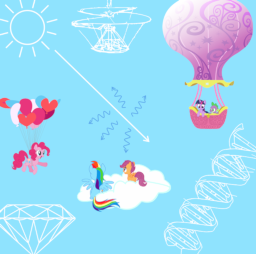
Animal Friendships

Vector by MelloNyan
Fluttershy and Twilight walked side by side through the woods on the edge of the Everfree forest, enjoying the sight of the treetops, the scent of the evening flowers, and the sounds of birdsong.
“The Everfree forest always seems like a different world,” said Twilight.
“It does,” agreed Fluttershy. “It obeys different rules… The plants grow, animals care for themselves…”
“And the clouds move all on their own,” finished Twilight. They giggled together.
“The rabbits feed on the grass,” said Fluttershy. “And the foxes feed on the rabbits, as well as the mice and shrews—who live on worms, slugs, spiders, and insects. They are also eaten by badgers, snakes—” Twilight winced “—and other predators. The timberwolves eat whatever it is timberwolves like to eat. It all forms part of a complex food web which keeps everything in balance.”
She paused and looked up into the treetops, meditating on the harmony of the natural world. “Nature is so fascinating.”
Twilight shivered and looked into the bushes, wondering what snakes they hid. “It’s a very cruel world out here. All these animals eating one another.”
“That’s how it is in the wild,” said Fluttershy, matter-of-factly. “But not all animal relations are about eating or being eaten. Some wild animals form important friendships—what we call mutual symbiotic relationships.”
“Symbiotic Relationships,” repeated Twilight. “I’ve read about those. Like the lichen we find growing on stones. It’s a symbiosis between a plant and a fungus—the plant can produce food from sunlight by photosynthesis, which the fungus can feed on. And in return, the fungus provides a structure on which the plant can grow.”
“Exactly,” said Fluttershy. “We also see mutual relations between animals. For example, crocodiles have special relationship with plover birds. They let them hop into their open mouths, so the plover can pick out the bits of food which get stuck between their teeth. The bird gets a meal, and in return it helps the crocodile keep their teeth in good condition.”
“It must be a brave little bird to hop into a crocodile’s mouth.”
“We have to trust our friends,” said Fluttershy. “Other animals have similar friendships. When a warthog is having trouble with ticks, they go to visit their mongoose friends. The little mammals will happily climb over the wild pigs to snack on the parasites. It’s a mutually beneficial relationship. The warthogs get cleaned up. The mongooses get a meal. Another example is the oxpecker birds, which live around large animals like giraffes and hippopotamuses, feeding on ticks and other parasites.”
“Zecora told me about those,” said Twilight. “They live with the zebras in her homeland. She said they could be a nuisance as they would sometimes peck at open wounds. But they could also keep an eye out for danger and scream a warming if they saw any lions or manticores.”
“Symbiosis also happens with creatures in the ocean,” continued Fluttershy. “There are the hermit-crabs—little crustaceans which live in old shells of other animals. They makes friends with a sea anemone. The anemone rides on its shell, and waves its stinging tentacles around to scare off any predator fish. They stay together for life. The anemone helps protect the crab, and the crabs helps feed the anemone and lets it move around.”
They walked further along the path leaving horseshoe prints in the soft ground. Fluttershy paused as two swallows swooped down across the path chasing insects. She smiled before continuing the lecture.
“Another example involves one of my favourite creatures—the three-toed sloth—they have such cute little faces.” She smiled at the thought of the sleepy tree dwelling mammals. “The sloth spends its life slowly moving high in the trees eating leaves. There’s a species of moth which lives in its fur. The moths live, mate, and die in their friend’s furry coat, and they help encourage the growth of green algae. The sloths eat the algae and it provides them with vital nutrients which they can’t get from the leaves.”
“What a strange animal.”
“We shouldn’t judge others’ cultures,” replied Fluttershy.
“All the same,” said Twilight. “I’d rather have a hayburger and fries for lunch than lick algae off my fur.”

I knew about all of those except for the moths. Nature truly is fascinating.
That looks more like the Whitetail Woods.